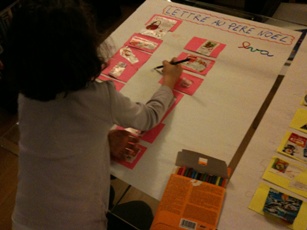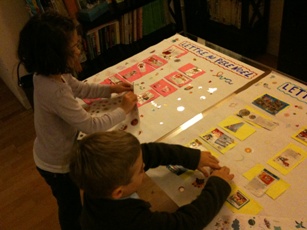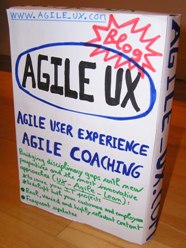Posted by jc-Qualitystreet on 2011/02/08
The question arises regularly… so here’s my own definition of agility:
« Agility is the ability of an organization to create value and to continuously delight the customer, while promoting and responding to change in its environment »
This broader definition completes a recent quote of my fellow french blogger Claude Aubry* on Twitter, and adds to Jim Highsmith’s definition ( »Agility is the ability to both create and respond to change in order to profit in a turbulent business environment » 2002) or Craig Larman’s definition (« Rapid and flexible response to change » 2004). While I found these good definitions very inspiring, I was missing something…
I was missing the CLIENT, the primary goal and core foundation of an organization, the means to align employees to a common vision and the key differentiator against competitors. Indeed, in today’s world of complexity and competition, the challenge is not only to deliver value early but mostly to continuously delight his primary customer.
This is the only viable purpose to be successful in the long term. For this, the agile organization must be both proactive, active and reactive, supported both by lean, agile and user eXperience practices.
Of course « being agile » is also a mindset based on core values: communication, feedback, courage, simplicity, respect and the four from the Agile Manifesto.
* « L’Agilité est la capacité d’une organisation à créer de la valeur, tout en s’adaptant -à temps- aux changements dans son environnement » 2010
Posted by jc-Qualitystreet on 2011/01/29
Marketing teams now who want to become Agile…
At Valtech (FR), marketers have already taken the opportunity to adopt agility in their own business.
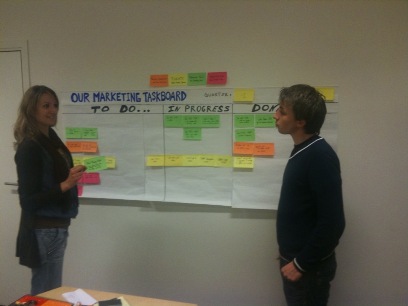
- AgileMarketing-The Daily Scrum
The team is small. Agile planning and visual management around a « beautiful » taskboard are the first agile elements the team wanted to experiment.
Every day in the morning, no more than 10 minutes, the team does its « Daily Scrum » to synchronize, measure progress and identify impediments. For them, Agile is a good way to work together and to build a relation of trust based on FEEDBACK, TRANSPARENCY and RESPECT.
And you know what? They like it!
Posted by jc-Qualitystreet on 2010/12/05
But also a necessity!
The era of agile and lean management (see Management 3.0: Being an Agile Manager) is announced, and many factors contribute to the awareness and the birth of a sense of urgency that can serve as a starting point of willingness to change to lead middle managers to become agile managers.

The Agile Manager: Leadeship & Facilitation
The Enterprise environment
Fast, complex, competitive, changing, the external environment impacts the company itself. Pushed to review its governance, processes and valuable assets, the organization must also differentiate itself from its competitors in terms of knowledge, information sharing, skills and career management. The agile and lean enterprise is an obvious answer to these challenges, and middle managers, first line for these activities, have a major role to play. Whether supporting or opposing, they will be highly impacted by the fundamental changes introduced by an agile and lean approach.
The Rise of agility
Agile methods have spread into projects and in the everyday business life of people. Very popular in IT projects, agility is now everywhere and difficult to avoid. Managers can’t ignore it anymore. Moreover to understand what people actually do and how IT teams work, middle management will require the appropriate level of agile information and training… first steps toward change?
Concrete and visible results
It’s also difficult for middle management to ignore the benefits provided by Agile methods. Agility enables organization to reduce time to market, to improve product quality, to increase project visibility and productivity. Better team satisfaction and better end-user satisfaction are also observed. Agile methods have shown their efficiency and proved that it worked. Ten years after the Agile Manifesto, birth of Agility, agile and Lean practices continue to spread at a « unsustainable » pace 🙂 With the appropriate level efforts, an agile and lean approach gives fantastic results. So, why not applying some of these good practices and using them as a source of inspiration for management activities?
People expectations
Of course some needs and expectations of working people (achievement, recognition, empowerment…) are not new but the agile mindset is! An agile mindset grows within team members working with agile methods, and changes their relationship with others, with work and with their company. Collaboration, courage, feedback, simplicity and respect, the fundamental agile values are now also expected outside of the agile team, and primarly with middle management and hierarchy. Trust and feedback will be the keys.
From a generational point of view, the rapid growing of digital natives (people born after 1978) inside companies also changes the face of the enterprise and how the businesses operate. Digital natives need real time interactions & collaboration, networks, communities and a new management style. Once again, I have the feeling that agile management is a very good option to address the needs of this specific population.
HUMANITY, FACILITATION, COLLABORATION and LEADERSHIP seem to be the key characteristics of the AGILE MANAGER. And inspiration can be easily found in these few principles of lean management:
- Base your management decisions on a long term philosophy… even at the expense of short-term financial goals
- Grow leaders… who thoroughly understand the work, live the philosophy, and teach It to others)
- Develop exceptional people and teams… who follow your company’s philosophy
- Respect your partners and suppliers... by challenging them and helping them improve
- Go and see for yourself… to thoroughly understand the situation
- Make decisions slowly by consensus… thoroughly considering all options implement rapidly
- Become a learning organization... through relentless reflection (Hansei) and continuous improvement (Kaizen)
Posted by jc-Qualitystreet on 2010/11/15
During an agile transition program, do not let your managers by the roadside! Rather help them to become Agile managers and to control the evolution of their profession.
The « era of management 3.0« (agile and lean) is announced so make the middle manager a key player for change, between opportunity and necessity…
The case of middle management
« Top-Down » or « Bottom-Up », there is no debate anymore. We know today that a top management support and the ownership by the teams are both essential to ensure the success of the transition to agility. No, the issues of the Agile Enterprise are now in intermediate managerial layers of the organization.

Towards an Agile Middle Management
How to approach them? How to convince them? How to transform them?
My experience with Agile projects and agile coaching in various sectors (banking, industry, software vendor …) showed me that this is the middle management that holds the keys to agility on the Long Term. Indeed, middle managers can be the most active supporters or the worst impediment and therefore the most dangerous opponent of the agile transformation.
The opportunity to become an Agile Manager…
With only one goal: the success of teams…
The « Command & Control » management style based on Taylorism and scientific management (OST) has shown its limits… the agile manager explores new dimensions (mostly related to facilitation & leadership) to ensure the success of all. The role within an agile organization becomes a clever trade-off between maintaining / abandoning some responsibilities and acquiring new skills.
So, even if every management role is unique, context-specific, here is the list of the 6 core activities of the Agile manager:
- (Still) Manage the portfolio of projects and coordinate with other managers
- Define projects strategy at the organization level
- Set priorities
- Define budget and resources
- Do the staffing
- Work with peers as a team
- (Still) Manage recruitment
- Hire people
- But also fire and solve potential conflicts
- Support Projects and Agile self-organized Teams
- Promote autonomy and self-organization
- Remove impediments that the team or ScrumMaster are not able to manage
- Manage logistics
- Buy the supplies
- Challenge teams and help them to improve their knowledge about products, tools, technologies, methods…
- Create a relationship of trust, develop (career) and motivate people
- Make yourself available
- Get to know each person and his work
- Facilitate the acquisition of new skills
- Give feedback
- Give work recognition
- Delegate tasks
- (Still) Create an environment for success and energize change
- Communicate the vision
- Give a direction
- Adopt the appropriate management style
- Simplify usage
- Seek performance through appropriate tools and processes based on continuous improvement and waste elimination
- Initiate, support and animate communities of practices
- Give time and resources to agile communities, ScrumMaster, Product Owner, Agile Manager, Architects, UX Groups …,
- Promote communities of practices in the organization
And my role as an Agile Coach?
Engage conversations with managers and support them in their journey toward becoming an AGILE MANAGER !
Posted by jc-Qualitystreet on 2010/11/11
Or Agility at Home 🙂
Christmas is coming and for the third year we’ve done with kids, our letter to Santa Claus, or rather our prioritized Backlog for Santa Claus.
With Agile and Kaizen mindset, we seek to improve our process (see our 2009 process – English or our 2008 process – French)
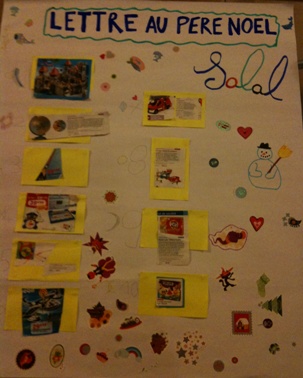
- A prioritized and customized backlog !
Same constraints as previous years
- Santa Claus is very busy
- His sledge is not expandable
- The deadlines are tight
- The delivery date cannot be moved
Other elements of context
My kids are now experienced Product Owners 🙂
- They handle sticky notes and patafix with dexterity…
- They know they cannot have everything (even if you always want more)…
- Being good (or not) has an impact on Santa Claus’s motivation to deliver what they wish…
SO , they realize they must prioritize their Christmas backlog !
How do we set priorities to write the letter to Santa Claus?
Step 1: Needs analysis, Brainstorming and data collection
Passionate reading for weeks, intensive research from several sources… confrontation with friends at school. « Workshop collaboration » with parents at home and, finally, cutting potential gifts

Catalogs...
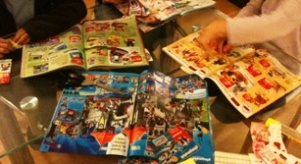
Brainstorming

Collaborative workshop with parents
Step 2: Backlog Initialization
Images are cut. Place one image by sticky note (pink ones for my daughter; yellow notes for my son). Question of maturity: this year my son was able to participate actively (he is now 3 ½ years old). The two backlogs are initiated.

One image by Sticky note

Backlog item example
Step 3: Backlog Prioritization
Notes are laid on the ground. My kids make their prioritization effort and rank them in order of preference. They place on the top toys they want most, the most important to them…

Prioritization effort

To set priorities: compare and use triangulation !
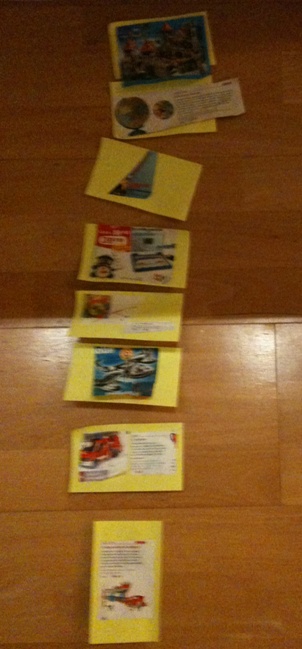
the list of items is prioritized
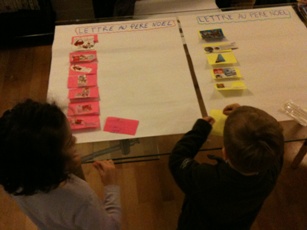
From the floor to the table
Step 4: Backlog Customization
Notes are now prioritized on the ground. We keep the principle of visual management but our product owner wish this year to customize their backlog.

- Final Backlog – Girl version
Step 5 : Backlog display
Go to the room for an optimal visibility

Visual management... In situ !
Results
We really had a great time and the children enjoyed it. They’re very very happy. And you know what ? … It was a pleasure to coach such good Product Owners 🙂













